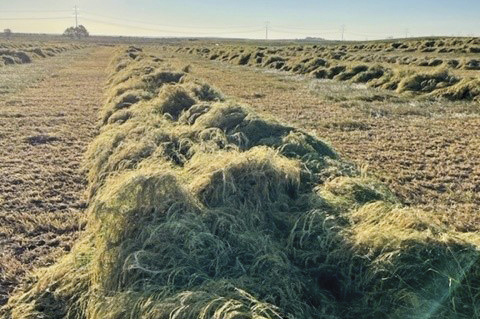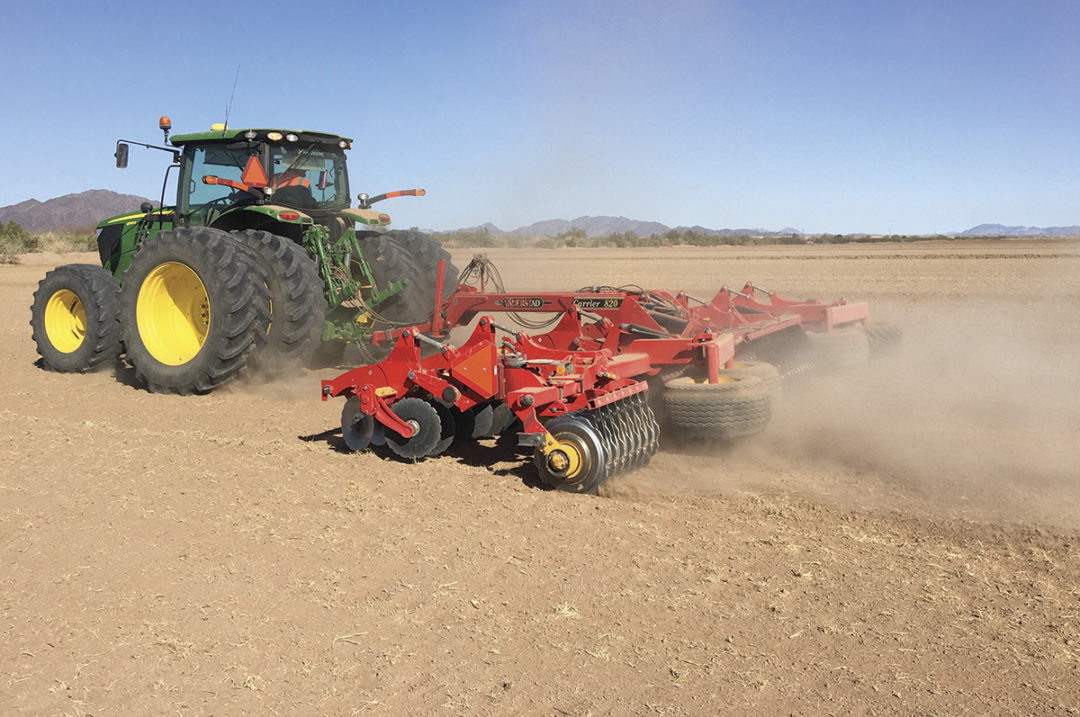“I keep meaning to drop by and ask David what he’s growing in that field,” says David Patrick’s neighbor – who farms several thousand acres. “I didn’t even know what it was.”
He’s talking about teff – grain teff in this case – that David has contracted for his farm south of Twin Falls. Traditionally grown in Ethiopia, teff is typically milled into flour to make breads. “We were looking for something to fill smaller acres when malt barley contracts were being limited, and this has worked,” David says. His teff is contracted through a Boise company.
Growing grain teff, David says, has been comparable to growing barley, but he says teff is harder in the respect that it’s slow-growing at first, so it’s not as thick or tall enough to get the soil shaded before weeds come. “I have to plan on spraying twice for weeds,” he says, whereas he only sprays once for barley.
David planted some teff acreage on Salmon Tract ground in 2021, even though he knew it would be a short water year. “I shorted the crop as much as I could and only put on 13 inches, but still got a fair crop,” he says. Compared to some neighboring teff that received full water, there was only a difference of a couple hundred pounds per acre in yield. (A normal water year would have meant using about 20 inches.)
Teff has some challenges that David says he hasn’t figured out yet, at least to his satisfaction. Harvest isn’t easy. Swathing begins about Sept. 1 (depending on the variety planting date). He currently mows the teff into a windrow, lets it dry in the windrow, then uses a combine to harvest the grain. “But it took two to three weeks to dry, and if there’s no rain it works out great,” he says – but how often does that happen? It’s slow going, he says. After the teff is harvested, the teff straw can be baled.
“Harvest timing works for us,” David says, as it takes the efforts of him and his son Dustin right up to the edge of silage harvest. They truck the teff directly from the field to the contracting company’s warehouse in Boise.
 Grain teff is cut and left in windrows to dry before combining. Photo courtesy of The Teff Company.
Grain teff is cut and left in windrows to dry before combining. Photo courtesy of The Teff Company. “Sugarbeets and alfalfa are the rotation drivers for me,” David says. “But [teff] gives us some flexibility to go for a high-paying crop for one to two years.” However, he quickly adds, “We don’t chase the markets. We find, however, that it’s a great crop to no-till sugarbeets into the following year.”
On the other side of the county, David’s cousin, Scott Patrick, also has contracted some grain teff. He started with a small acreage of teff to replace some of his dry bean acres. This year, he’ll have 150 acres.
“Dry beans take more inputs,” Scott says. “And teff doesn’t have mold issues like beans can, and I haven’t found an insect yet that likes it – so spraying for pigweed is about all the care it needs. I only needed 30 to 40 units of nitrogen per acre. It’s so much easier than beans to grow,” he says. “The chemicals are simpler. There’s no storage or cleaning. And [at least this year] it was twice as profitable as beans.” Scott also contracts with a company in Boise that mills the teff for flour.
One of the challenges Scott has had with the teff, however, is figuring out the variables for planting. Planting begins at the end of April or first of May. In 2019, they used an air planter and, in 2020, they used a grain drill. “My planter minimum is one-half-inch, and in 2020 we put on 3 pounds per acre but actually got less yield [other inputs being the same] as compared to 2019 with 2 pounds to the acre,” he says. “We’re thinking heavier seeding actually cost us some yield,” with 2019 yield at 2,200 pounds per acre and 2020 yield at 1,600 pounds per acre. The seed is really small (over 1 million seeds per pound), “So dialing into an exact seeding rate is difficult,” he says.
There is one other downside, Scott says. “You can’t spray out other grasses, as teff is a warm-season grass and there’s nothing labeled in the U.S. for use on teff to control other grasses.”
Scott would also like to find a better way to harvest. They tried windrowing it with a 25-foot draper header and then combining it after it had dried in the windrow, “… but a windrow inevitably has green spots that plug up the combine,” he says. This year, they’ll try using an 18-foot auger header and see if this makes a difference. He bales the leftover straw and sells it to a local dairy for bedding, and his 2020 crop produced 2.5 to 3 tons of straw per acre.
“It’s easier than beans,” Scott emphasizes. “Not as easy as wheat or barley, but the market is better.”




.jpg?t=1687979285&width=640)
.jpg?height=auto&t=1713304395&width=285)


